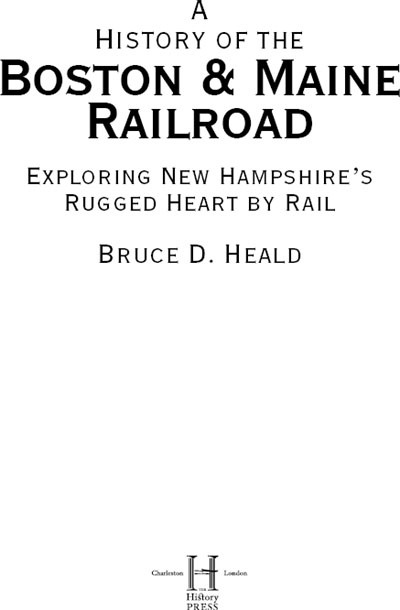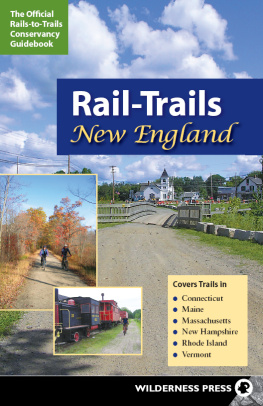

Published by The History Press
Charleston, SC 29403
www.historypress.net
Copyright 2007 by Bruce D. Heald
All rights reserved
Front cover: The Profile & Franconia Notch Railroad was a narrow-gauge line that served the Profile House and the Maplewood Hotel. This short line went as far as Bethlehem. Above the train station is Eagle Cliff (left) on Mount Lafayette. Courtesy of the B&M Railroad Historical Society.
Unless otherwise noted, all images courtesy of the author.
First published 2007
Second printing 2010
e-book edition 2013
Manufactured in the United States
ISBN 978.1.62584.405.7
Library of Congress Cataloging-in-Publication Data
Heald, Bruce D., 1935
A history of the Boston & Maine Railroad : exploring New Hampshires rugged heart by rail / Bruce D. Heald.
p. cm.
Includes bibliographical references.
print edition ISBN 978-1-59629-360-1 (alk. paper)
1. Railroads--New England. I. Boston and Maine Railroad. II. Title.
TF23.15.H43 2007
385.0974--dc22
2007035334
Notice: The information in this book is true and complete to the best of our knowledge. It is offered without guarantee on the part of the author or The History Press. The author and The History Press disclaim all liability in connection with the use of this book.
All rights reserved. No part of this book may be reproduced or transmitted in any form whatsoever without prior written permission from the publisher except in the case of brief quotations embodied in critical articles and reviews.
The story of the Boston & Maine must be told to remind us of the joy and pleasure it brought to the many vacationers and commuters in New Hampshire during the nineteenth and twentieth centuries.
CONTENTS
FOREWORD
While the Boston & Maine Railroad operated in Massachusetts, Maine, Vermont and New York, in none of those states was it as woven into the fabric of daily life as it was in New Hampshire. From 1895, when it acquired the Concord and Montreal Railroad and gained nearly total hegemony in the Granite State, until the end of World War I, when the automobile took hold, nearly everyone and everything that moved into and out of New Hampshire was carried on the B&M.
Visualize, if you can, a New Hampshire of not so long ago where paved roads are a rarity and the motorcar is nowhere to be seen. How will you visit your relatives in Claremont? How will your son get to school at Exeter or your daughter at Durham? How will the new icebox you ordered get to the local hardware store? How will the summer people who patronize your shop arrive in town? How will you escape the routine cares of daily existence for a trip to the Worlds Fair?
With relentless regularity the B&M conveyed the mail, carried the milk and delivered the flour, nails, stoves, newspapers and all the necessities of life. It did this in all kinds of weather, answering only to the demands of the timetable and the staccato click of the dispatchers telegraph key.
And if the humdrum regimen of the B&M at work fails to conjure up appropriate images in the minds eye, turn its gaze to where the B&Ms myriad main lines and branches reached deep into the rural recesses of New Hampshire, bringing tourists and summer campers to its places of unparalleled beauty. If the B&M did not originate the tourism industry in New Hampshire, it surely institutionalized it. And if the automobile brought New Hampshires recreational reputation to the broadest audience, it was the B&M and its predecessors that set the stage and created the demand.
Through its depot gateways summer visitors debarked from trains originating in Boston, New York or Philadelphia to enjoy the New Hampshire seashore, its refreshing lakes and its romantic hill towns.
What are todays links with New Hampshires railroad past? Some of the depot gateways, Ashland and Lisbon for example, have been restored by civic-minded citizens; still others have been thoughtfully preserved by their owners. The archaeologically inclined can trek through the woods or follow rail trails to discover bridges, culverts, mileposts and other evidence of the old B&M. Though most of the trains are gone, at least three scenic railroads polish rails that would otherwise have been abandoned.
For many of us, though, it is the photograph and the written word that remind us best of the time when vaporous clouds surrounded a steam engine on a cold day, when the streamlined Mountaineer was boarding at Fabyans or when a visit to the depot found the freight men unloading from the flatcar anything from soup to nuts.
With Dr. Bruce D. Healdcollege professor, veteran purser of the Mount Washington and keen observer of everyday life in New Hampshireas your tour guide and the photos and materials of the Boston & Maine Railroad Historical Society Archives as your inspiration, come aboard with us and spend a few relaxing hours looking out a parlor car window in the days of the New Hampshire dynasty.
Frederick N. Nowell III
Author/Archivist for the
Boston & Maine Railroad Historical Society
ACKNOWLEDGEMENTS
I would like to thank the following people and organizations for their assistance: John C. Alden, John Anderson, the Appalachian Mountain Club, Charles E. Beals, Francis C. Belcher, the Boston & Maine Railroad Historical Society, Waldo G. Browne, Frank H. Burt, A.W. Cooper, Alfred K. Chittenden, Samuel A. Drake, Bill Gove, Karl P. Harrington, G.L. Johnson, Charles Kennedy, Thomas Starr King, Frederick W. Kilborne, Lisa B. Mausolf, J.W. Meader, H.H. Metcalf, James Nigzus, Frederick N. Nowell III, Henry V. Poor, Richard H. Sewell, Agnus Sinclair, M.F. Sweetzer, Stuart R. Wallace, the New Hampshire Department of Transportation, Reverend Julius H. Ward, the White Mountain Region Association and Arnold H. Wilder.
CHAPTER ONE
A NEW HAMPSHIRE DYNASTY IS BORN
There is no question among most railroad historians of New England that the Boston & Maine Railroad ranks as one of the most important rail systems in the Northeast. In less than sixty years, the Boston & Maine rightfully became a railroad dynasty.
The earliest date for the birth of the Boston & Maine Railroad is 1833, when the line was chartered under the name Andover & Wilmington Railroad. This was an eight-mile line in Massachusetts, which was intended to connect the towns of Andover and Boston over the tracks of the Boston & Lowell Railroad. It was recorded that the line was opened in 1836, its major stockholder being the Andover Academic and Theological Seminary.
In 1835, the stagecoach system and river boating companies were well established and New Hampshire folks felt that they were well-off as far as transportation was concerned. They paid little attention to any rumors about steam railroads. Then in a few years there was talk of running a railroad into New Hampshire. People everywhere fought the idea. They said these funny little engines and their trains of little cars would scare the cows, stop the hens from laying and set fire to their fields and forests. But the railroads came just the same.
In 1835, the Boston & Maine acquired a New Hampshire charter and was incorporated as a separate New Hampshire entity called the Boston & Maine Railroad. That same year the line was opened from the Massachusetts state line to Exeter in 1840 and to Dover, New Hampshire, in 1841. Soon after, a charter was procured for the rest of the planned extension to be known as the Maine, New Hampshire & Massachusetts Railroad. The strategy of incorporating in all three states soon proved to be crucial in the future development of the railroad line.
Next page













